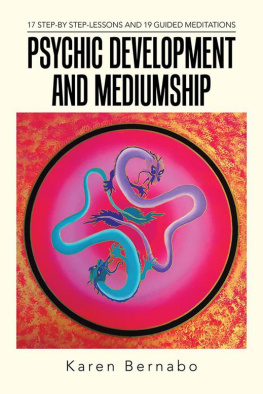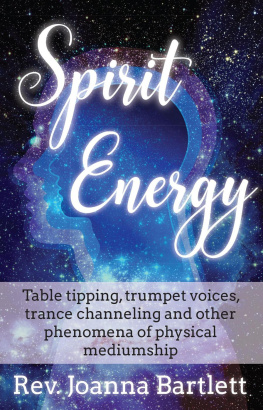By the same author
Game Wardens
Cotopaxi Visions: Travels in Ecuador
Life Between Life
The Case for Reincarnation
Predictions
Toronto
Skin Dive
The Siren Call of Hungry Ghosts
Copyright 2001 by Joe Fisher
All rights reserved, No part of this book may be used or reproduced in any manner whatsoever without prior written permission except in the case of brief quotations embodied in critical articles or reviews. For more information contact Paraview Press, 1674 Broadway, Suite 4B, New York, NY 10019, or visit our website at www.paraviewpress.com.
Cover image courtesy of NASA/JPL/Caltech
Back cover photograph: Sherry ONeil
Book design by Smythype
ISBN: 1-931044-02-3
Library of Congress Catalog Card Number: 00-108792
PRINTED IN THE UNITED STATES OF AMERICA
This book is dedicated to my dear
mother, Monica, who has always
insisted that demonsdoexist.
Contents

Foreword
B efore I was halfway through this book, I realized that The Siren Call of Hungry Ghosts is one of those permanent classics of the paranormal, like Tyrrells Apparitions and Myers Human Personality and Its Survival of Bodily Death. And before I had finished it, I became aware that it is also one of the most disturbing books about ghosts ever written.
To understand just why The Siren Call of Hungry Ghosts is so important, it is necessary to speak briefly about the history of psychical research.
Until around the middle of the nineteenth century, the whole subject of ghosts was regarded as highly dubious. Most educated people accepted unconditionally that ghosts were superstitious nonsense which had been unmasked by the great scientific revolution of Galileo and Newton. England had two famous hauntings in the 17th and 18th centuries: the Phantom Drummer of Tedwortha poltergeist that made loud drumming noises and threw objects aroundand the Cock Lane Ghost, which restricted itself to knocks. Both were denounced as frauds although first-hand accounts now make it obvious that both were genuineand the unfortunate tenants of the house in Cock Lane were even sentenced to prison. The Age of Reason was quite determined that ghosts did not exist.
All that began to change halfway through the nineteenth century or, to be quite precise, on March 31, 1848, in the house of a farmer named Fox, at Hydesville, New York. The Foxes had been kept awake for several nights by loud rapping noises, which they assumed to be the shutters banging in the wind. But as James Fox went around shaking the shutters, to make sure they were tight, his daughters observed that banging noises seemed to reply like an echo. So, when the noises began again in the middle of the night, 12-year-old Kate said cheekily: Mr. Splitfoot (i.e. Mr. Devil), do as I do. And as she snapped her fingers, the rapping sounds imitated her.
Mrs. Fox then asked the unseen knocker whether, if it was a spirit, it would make two raps; two thunderous bangs were heard in reply.
The Foxes called in the neighbors as witnesses, and one of them, bolder than the others, managed to get the spirit to answer questions in a code of raps. It explained that it was a peddler who had been murdered by the previous tenant, and buried in the cellar. But digging in the cellar failed to reveal the body. It was not until more than half a century later, in 1902, that a wall in the basement collapsed, revealing another wall. Digging between the two walls unearthed a skeleton and a peddlers tin box.
During the summer of 1849, the rappings in the Fox household soon turned into typical poltergeist phenomenaobjects thrown through the air, and people touched, and pinched, by invisible hands. When the two daughters were sent to other homes, the manifestations followed them. Back at home, Mrs. Fox was hit on the head by a hairbrush. Mr. Foxs hair turned white.
The spirits eventually dictated a message ordering those who believed in them to start a Church of Spiritualism. You must proclaim this truth to the world. On November 14, 1849, the first Spiritualist service took place in Rochester, New York, and the new religion spread all over America. A regular feature of these meetings was a medium who went into a trance and contacted the other world. Phantom hands sometimes played musical instruments, and, on occasion, the dead even materialized so they could be seen and touched.
Inevitably, the scientists were enraged at what seemed like an outbreak of medieval superstition, as absurd as the witchcraft craze. Yet many scientists who were persuaded to investigate ended up convinced that the phenomena were genuine. In 1882, a Society for Psychical Research was formed in London by eminent intellectuals, scientists, writers, and politicians; its aim was to try to discover, once and for all, whether all this talk about life after death was nonsenseand, if not, then what it was. They were convinced that they would solve the problem before the end of the centuryafter all, this was the age when science was making tremendous discoveries in the realms of stars and atoms. But the proof they sought eluded them. Clearly, all the phenomena were not fakery. Yet they simply refused to yield up their secrets. There was always just enough evidence to confirm the belief of the believers, yet never enough to convince the skeptics.
As a young man, G.K. Chesterton and a group of friends began to experiment with a planchette, a pencil on wheels that can produce automatic writing. Asked the name of a distant relative, the board spelled Manning. They informed the spirit that this was not true. Married twice, it replied promptly. To whom? Cardinal Manning, said the spirit. Chesterton remarked that he had no doubt that some mysterious and unknown force was involved. But there was one major drawback: it told lies.
This has remained one of the major problems of investigators ever since. The evidence that something strange is going on is overwhelming. But it never quite makes sense.
At this point I should say: Now read on. But perhaps this would be too abrupt. Let me simply say that while Joe Fishers experience was just as baffling as that of so many other investigators, it makes a far better story than most (so good that I have retold it in three of my own books), as well as raising some worrying questions.
Joe Fisher is a British-born author and journalisthe now lives in Canadawho, in 1984, wrote an excellent book called The Case For Reincarnation, which is certainly among the best accounts of the subject ever written. The Dalai Lama himself recognized the seriousness of the work when he agreed to write the preface. I had read the book long before an editor asked me if I would like to review the originally-titled Hungry Ghosts, so I lost no time in accepting.
The book was not only as good as I expected; it was so stunning and compulsive that I read it straight through in three hours. When Mr. Fisher and his mother came to visit me a few years later at my home in Cornwall, I found myself looking at this charming and good-looking man with a kind of incredulity, hardly able to believe that he had been through such extraordinary experiences. But our long conversation left me in no doubt that his air of youthful candor masks the mind of a brilliant investigative journalist.















